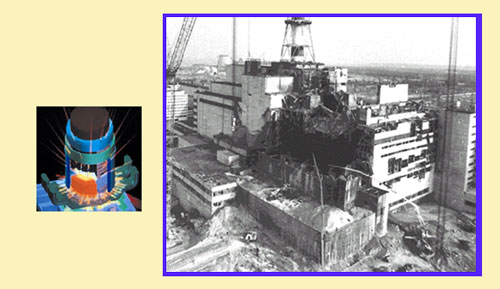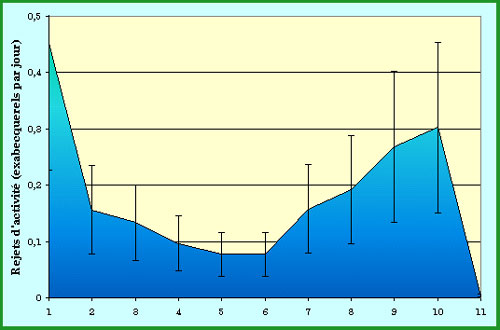An explosion followed by a graphite fire
In 1986 the Ukrainian Chernobyl plant had 4 RBMK reactors. This type of reactors was known to have inherent design weaknesses: no containment enclosure, existence of unstable operating regimes, slow and insufficient reactor safety and control bars . However, reactor number 4, which entered in service in 1984, could have continued a long career if a team of operators did not have conducted an unfortunate experience during a planned shutdown of the reactor.

The damaged reactor
On April 26, 1986, the core of the Chernobyl reactor No. 4 exploded. Fragments of the core were thrown through the roof, from which radioactive dust escaped during ten days. The picture shows the state of the reactor after the explosion, before the construction of a sarcophagus prevented radioactivity in the lava and remaining structures from spreading in the environment. Behind, one can see the twin unit No. 3 that continued to operate until December 2000.
© DR
By reducing the reactor power, operators made it enter into an unstable operating region where the reactor could be operated only in accordance with strict security instructions. To complete the test, operators made mistakes that led them to violate these guidelines. Given the instable regime, these actions finally cause the accident.
A fatal spiral
Here is briefly summarized the fatal spiral that led to the destruction of reactor number 4 on April 26, 1986:
– April 25, between 1p.m. and 11p.m.: The reactor is kept at half-power to meet electricity demand.
– April 26: Around 11p.m, operators rresume the shut down procedure, but the reactor powers falls abruptly : the reactor is not stable anymore. Nevertheless, operators try to raise the power up.
– 1:15 a.m.: In violation of procedure, the operators decide to continue the test anyway and disable eventual emergency shutdown signals.
– 1:22 a.m.: The reactor computer orders an immediate shutdown. Again, the staff decided, however, to continue the test.
– 1:23:04 a.m.: The inlet valves of the turbine are closed: steam pressure in the reactor increases.
– 1:23:40 a.m.: The chief operator orders the emergency shut down : The safety control bars are lowered into the core. In vain. They introduction is too slow.
– 1:23:44 a.m.: The power peak is reached.
Under the effect of the heat released, the cooling water evaporated, the pressure tubes containing the fuel rods burst and, under the effect of the team pressure, an explosion raised the concrete roof of the reactor, weighing 2,000 tons, ejecting radioactive fragments of fuel elements and causing about thirty blazes. It took three hours for firefighters to extinguish them.

10 days of radioactive releases
Radioactive releases during the accident lasted 10 days. Two explosions were responsible for the initial release of radioactive material in a cloud, several kilometers high, then dispersed in the form of plume, a part of which went higher than 1200 m. The reactor core left bare and the continuing fire of the graphite moderator were later at the origin of a continuous release of large quantities of radioactive material into the atmosphere (as gases, aerosols and particles). The graphite moderator fire was stopped only after 10 days.
© IN2P3 (Source: Atlas de Tchernobyl).
A graphite fire
At the same time, the graphite ignited : gas and radioactive dust were released for 10 days. The intense heat in the core that was not longer evacuated maintained the fire. This heat was mainly due to radioactive decay of short lived fission products. The heat decreased slowly, still corresponding to tens of thousands of kilowatts at the end of a week.
The upper part of the reactor stood in open air. From April 27 to May 10, 5000 tons of materials (sand, boron, clay, lead…) were dumped by helicopter to cover the reactor.
It took six serious human errors to cause disaster: two voluntary violations of standing orders, a failure to comply with the planned test procedure and three voluntary disabling of automatic protections. The accident would not have happened if only one of six errors had not occurred.
Other articles on the subject « Chernobyl accident »
Chernobyl Liquidators
A heavy toll paid by firefighters and liquidators: The magnitude of the disaster took the Soviet [...]
Radioactive Releases
Radioactive releases and contaminations at Chernobyl The explosion of the reactor led to the disp[...]
Chernobyl Plume
A deep mark in the french collective unconscious « The Chernobyl cloud has stopped at the french [...]
Chernobyl Exclusion Zone
A no man’s land turned into a natural reserve ? On April 27th, 1986, one day after the expl[...]
Chernobyl Health Effects
Chernobyl: A toll still impossible to quantify It is difficult to reach an approached assessment [...]
Chernobyl Iodine 131
A dangerous radioelement during the first weeks Iodine-131 is the most feared fission product whe[...]
Chernobyl Caesium-137
The accident long term legacy More than twenty years after the Chernobyl accident, attention focu[...]
Chernobyl Today
The Chernobyl Site Over 30 Years Later On December 15, 2000, the Ukrainian government, in accorda[...]